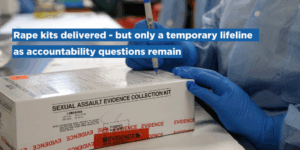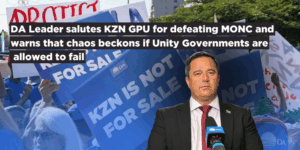Residents from Wingfield informal settlement in Kensington got first-hand experience of the effectiveness of drone technology as part of early warning systems for high-risk areas, in the event of a disaster.
The City’s Disaster Risk management centre (DRMC) hosted a two-day capacity building workshop for the residents, to observe International Day for Disaster Risk Reduction on Thursday 13 October.
International Day for Disaster Risk Reduction was started in 1989, after a call by the United Nations General Assembly for a day to promote a global culture of risk-awareness and disaster reduction.
The workshop was organised by the DRMC in a partnership with DMS NPC, a disaster risk management company and QP Drone Tech.
Participants were educated on different types of disasters, and mitigation measures, as well as compiling a list of hazards applicable to their environment, and what could be done to mitigate the risks associated with these particular hazards.
The DRMC also focused on early warning systems that could be implemented in the event of a disaster.
Charlotte Powell, spokesperson the City’s disaster management, says the 18th Avenue informal settlement was identified to be part of the programme, as the area is prone to localised flooding during winter.
“We started the programme here so that we can start capacitating in terms of being more prepared and being more resilient. We introduced them to disaster management concepts. We showed them how the drone speaker can be used to give early warning messages to the community so when the drone flies it can send out these messaging in terms of what they need to do.”
Francis Hoets, Chief Executive Officer DMS NPC, says: “We have used the two days to show the importance of collaborating with communities and doing skills transfer of what the community early warning looks like. But importantly gathering their local knowledge to build the early warning system around their requirements and their needs.”
She adds: “Residents here got to take their knowledge from the workshop and present examples of early warning that they can implement in their areas around fires, human diseases and flooding.”
Queen Ndlovu, founder of QP Drone Tech, says drones are an effective tool to use during disasters.
“You can attach a speaker to the drone, so that in the event of a disaster announcements can be made. Drones can also be used before disasters by flying the drone over the informal settlement and it displays the risk areas. This information is then shared with the local government and the community to plan together how to close these gaps to avoid uncontrolled situations.”
JP Smith, Mayco member for safety and security, says in the event of an emergency, the right information needs to be spread to many people speedily to save lives and safeguard property.
He says, globally, examples of early warning systems are the ones in place in the event of a tsunami, to allow time for evacuation and reduce the risk to public safety.
“Here in the city, our communication around adverse weather forecasts, and what residents can do to reduce the impacts, is quite well established. It is very important for local communities too to have a means of communicating important messages or risks effectively.”
Ilona Crouch, community leader in the informal settlement, says she found the workshop insightful.
“We learnt to be aware of what to look out for when in dangerous situations. Having the drones means there will be less disasters like fires and flooding. It will also help with the illegal dumping.”
Another resident Vanilsa Abrahams feels the workshop was beneficial.
“They taught us what the drone is capable of doing and how it can save many communities. It can point out where there is danger. The workshop taught us how to be alert so that we can react timeously.”
Anton Bredell, Western Cape Minister of Local Government, Environmental Affairs and Development Planning, says the day is recognised through the Sendai Framework for Disaster Risk Reduction 2015 to 2030.
“The day is a global platform that gives us the opportunity to renew our local preparedness for disasters, as well as plans for risk reduction during unforeseen events.”
South Africa is one of 187 countries that signed and agreed to the Sendai Framework’s goals of significant reductions to loss of life and livelihoods caused by disasters by 2030.
The Framework is also aligned to the United Nations Sustainable Development Goals, as well as the Paris Agreement on Climate Change.
Bredell says since 2000, the province experienced 19 major floods and two significant droughts, with the 2018 drought and the threat of Day Zero.
Fires occur on a yearly basis with the most severe being the Knysna Fire in July 2017.
In this fire an estimated 900 formal houses were destroyed, and 1 533 households were affected.
“Infrastructure damages came to approximately R5 billion. During this time the province also had to deal with the unacceptable attacks on foreign nationals in 2008 and the Covid-19 pandemic from 2020 to 2022,” says Bredell.
To prepare for climate related disasters, the Western Cape uses an Impact Based Weather Warning System, based on seasonal and daily forecasts from the South African Weather Services.
“Seasonal forecasts are used to anticipate future droughts and assist with the planning of proactive water saving measures. Daily forecasts are valuable for anticipating events such as floods, or conditions favourable for wildfires, especially during the summer months. This information also enables first responders such as Emergency Medical Services, Fire and Rescue, as well as Safety and Security Services, to prepare and respond to emergencies.
Bredell said the Provincial Disaster Management Centre has a dedicated unit responsible for the distribution of warning information to all relevant stakeholders, including municipalities and provincial departments.
According to Ivan Meyer, Western Cape Minister of Agriculture, the province has been experiencing an increase in the intensity and frequency of disasters over the last ten years.
Meyer says for this reason, the Western Cape Department of Agriculture provides agricultural disaster risk reduction (prevention, mitigation, preparedness, response and relief) support services to producers and other clients.
These include support to farmers affected by drought, floods and pests.
“The R48,1 million allocated towards fodder support meant that the Western Cape could offer approximately 1 450 farmers fodder support for three consecutive months this year. In addition, the (department) issued seed vouchers valued at R324 000 to 29 farmers in drought areas that have shown signs of recovery. The aim is to support veld restoration.”
Recently, locust outbreaks in parts of the Western Cape have become a worrying factor for local farmers.
Meyer says: “The Department responded to the recent locust outbreak by allocating R4,9 million towards procuring 100 sets of Personal Protective Equipment such as gloves, masks, boots, overalls and 49 sprayers and 11 800 litres of pesticide”.
Meyer emphasised that disaster risk reduction will not be possible without successful partnerships.




